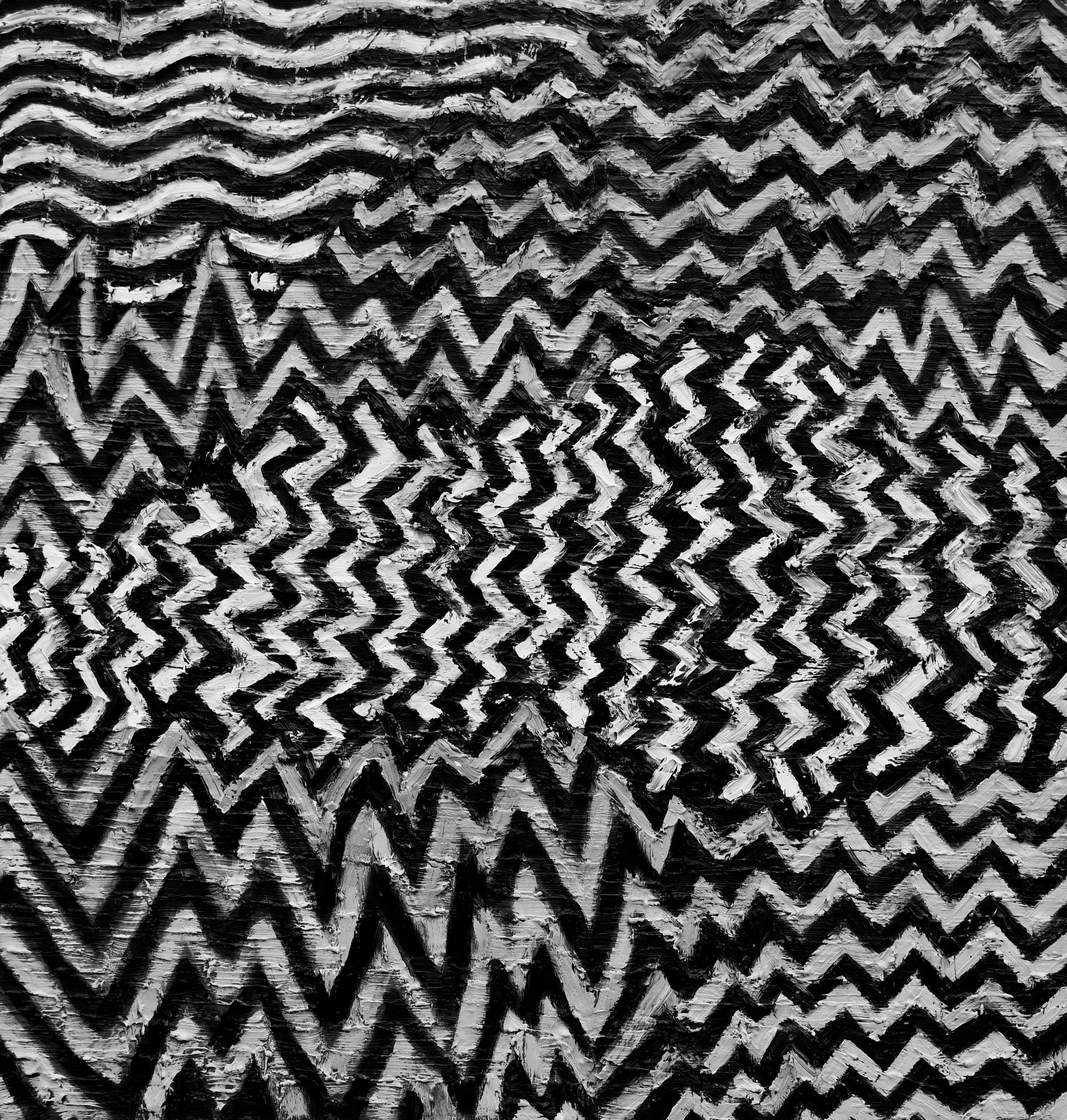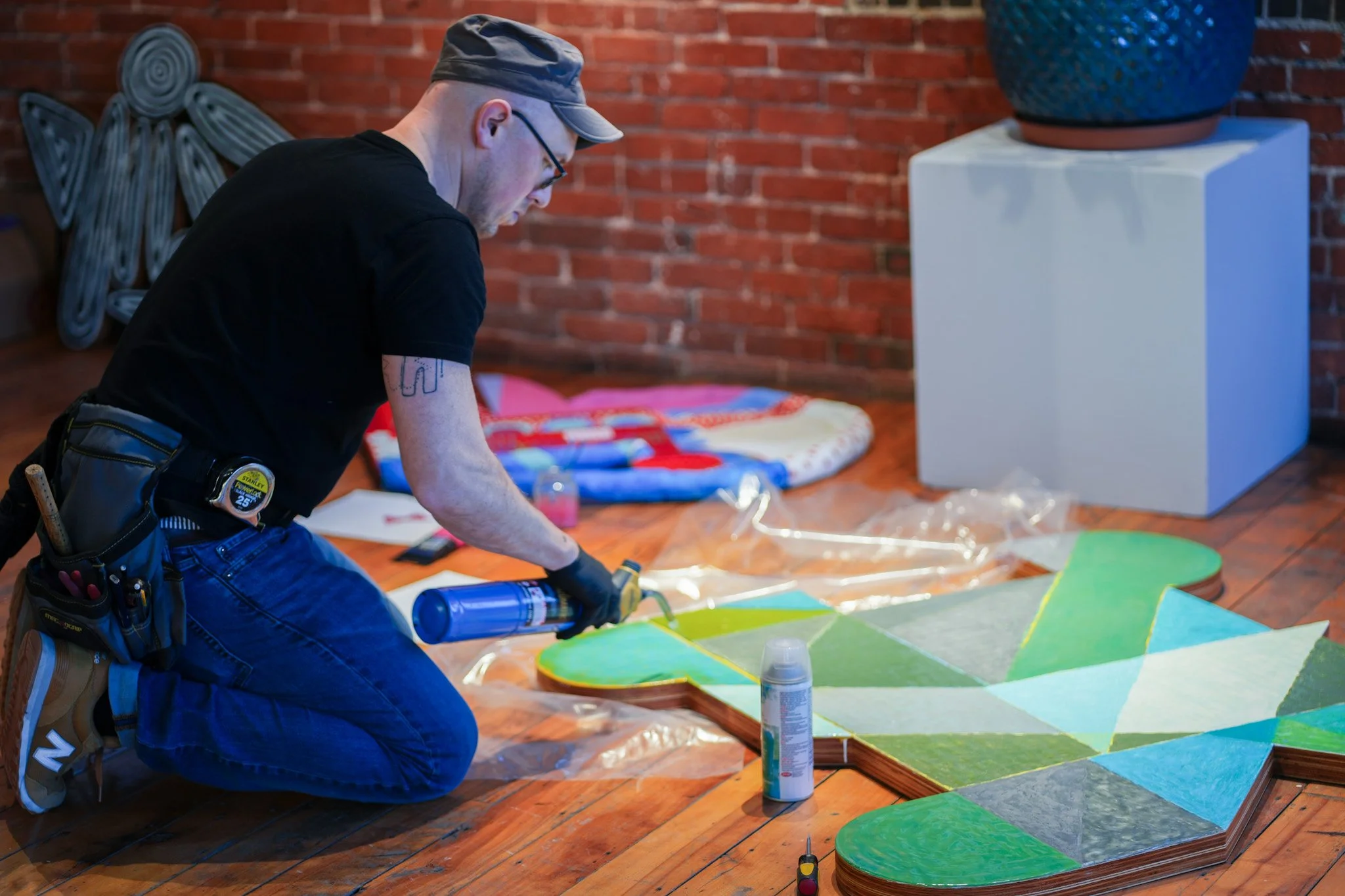THE MAKING: WITH TIMOTHY KADISH
After wrapping up the fourth day of installing Chalky Wrinkle Shape Shine, Essex Art Center’s current exhibition, Executive Director, Monica Lynn Manoski, and artist Timothy Kadish, sat down for a conversation.
Monica Lynn Manoski: Timothy, congratulations on creating an electrifying and joy-filled show. When I move through the space, I can’t stop smiling! I am so excited for our community to see your and Jai’s work. Thank you for the time, energy, and passion you poured into making your work and installing this show.
Timothy Kadish: I love Essex Art Center. I love the work you do, the artists you work with, and how the space has transformed. I'm deeply honored to be part of this exhibition with Jai Hart. I loved working with the space, finding the nooks and crannies, all the unique angles of the walls, and trying works in various spots. Through the install, I came to new understandings about the work. We paired works in new ways and chose unusual hanging heights, and the whole process felt very alive. It was an experience of creative expression, not unlike making the work itself. So thank you for joining me and offering your unique vision—from the poetic title of the show, to the colors of the walls, the design of the postcard—everything that comes along with your genius.
Timothy, Jai, and Monica installing Jai's work on the Essex Art Center's gallery wall
MLM: Wow, Timothy, thank you. That is a more generous compliment than I'm comfortable receiving, but I appreciate your kind words nonetheless. It has been a delight working with you and Jai, and I’m grateful that you both welcomed me to play alongside you for this show. Let’s dive into the questions. Did you always know you would be an artist?
TK: The story of becoming an artist is a little bit funny because of its sincerity and seriousness. As a young child, I taught myself the grid method, how to enlarge through perspective, how to work with line and shade and color in a very mathematical way. The line goes here, the light goes there. I have memories of riding in the back of my parents’ station wagon, with big bumps and lots of shaking, and yet I was able to draw realistic sharks and whales and other things that I was interested in. As I grew older, I would do some portraiture and things. But for me, it was always a little bit of a trick or an attention-getter, because I could do it easily. I just had the ability from an early age, and I think because I could do it, it wasn’t interesting to me.
When I went to high school, I was immersed in an incredible arts program. The materials and support seemed endless. The program was so great, I didn't even understand how good it was. But it was there that I was introduced to the idea that you could make anything! Which naturally led to the important question, “What do I want to make?”That blew my mind wide open and changed my perspective about being an artist. I worked tirelessly to understand what I could make, what I wanted to make, and who I was. Eventually, making art was an important part of who I was, it kept me sane and balanced, and it helped me process the world I inhabited. And before I knew it, I became an artist, even though that wasn’t my intention.
Stratum: Wavelength II, 2018, 42” x 40”, oil on canvas
MLM: Learning that you did not want to be an artist, but came around to it is so interesting. And I love that you mention the importance of discovering who you are and what you want to say.
Your work employs a complex layering system of paint, forms, and textures. I think it is fascinating to understand how you often return to works again and again. Can you talk about your process and the amount of time you spend on a piece?
TK: I am very process-oriented, despite the fact that I like to think of myself as not process-oriented at all. It has to do with the way I'm built and structured. My mind likes systems. Both of my parents are accountants, and my mind works similarly to theirs, though I swap out the numbers for materials. This medium plus that medium equals my art. My paintings are the solution to these alchemical equations.
On the nature of time, I have some work that will sit for 10 years or so until I truly understand the final flourish it needs to complete it. I have some that I can do over a day or two, but my real process involves working on multiple pieces all the time, touching each one in succession, as paint dries or an idea comes, I prepare the next one. It is a collaboration with myself, honestly. And these multiple works get multiple variations of attention and focus and mediums, and they all end up happening together and learning from one another.
Timothy adding some touches to his piece "Form Detail G"
MLM: You have several bodies of work that are very distinctive. Here, we’re presenting bold, geometric pieces, many of them distinctively textured, and many of them are black and white. Can you give our audience some insight into what they'll see at the Center?
TK: The primary body of work is my encaustic works, which is wax painting. And these wax works are on uniquely shaped wood structures and panels, which move away from the traditional square or oval canvas. These shapes get me really excited, because I'm changing part of my equation. I swapped out the rectangle for a form that has no recognizable history, one that I made, one that speaks to what I call magnifications. A lot of the inspiration has to do with my imagination and seeking to interpret and present what the fabric of our reality is. I also consider how to represent an idea before it's clear. What is the moment before Eureka? These works are deep magnifications of moments that truly don't exist until we are aware that they did exist at some point. The black and white pieces illustrate a favorite patterning, structure, and format. I'm enamored by nature itself, such as the zebra stripe, or how some creatures have a black and red coloring that's meant to be a warning for poison or to catch your attention or to be camouflaged in some way. I am fascinated and influenced by the things around me. Here I am working in black and white for its intense contrast, for its unique optical possibilities. The main gallery has many of these black and white patterned pieces interspersed between Jai Hart's fabulous and colorful soft forms.
Form Detail C, 2018, 45” x 48” x 2”, beeswax, oil, damar crystals on wood
MLM: I love how you work with and transform materials—from how you shape and build the structures you work on to the richly textured oil paintings and milky-smooth and bubbled-over encaustic surfaces. It's fun to watch people get really, really close to your paintings—the deeper you look, the more you see. Can you speak to the meaning behind the layering you do and describe how you've mastered working with your chosen materials?
TK: I work in all kinds of mediums, and while I went to art school, I am mostly self-taught. I like things well built, and technique is important too. I really care about these things. So, I often over-engineer my pieces. The work is very considered. But when I get started, I'm picking my materials and purposely choosing the ground I work on. For example, I love linen so much that I want the viewer to see it. So I developed techniques using rabbit skin glue and water based media, so that you can still see the linen and it becomes part of the subject matter.
When I get to a place of understanding, while having this incredible ground that I've invested in, not only monetarily, but in my time and the mediums and materials, I start to relax. I finally have a ground that speaks to me. And I really love natural materials. I prefer to draw on stone over paper. Stone responds, and I can feel it in a different way. I prefer to carve my marks instead of drawing them. When I carve, I draw with a diamond bit. One example of my carved works is hanging in your office.
I often think of my studio very much the way a scientist might think of a lab trying out different ideas and feeling it through, and putting it aside, trying out something new and then combining them later. My studio practice is my gift to myself, and it's how I process the world.
MLM: You are deeply connected to your intuition and have a rich spiritual practice. How does that show up in your work?
TK: My creative and spiritual practice are nearly identical. They are just different variations of the same source and the same intention. When I create physically with color and form and material, I am tuned in. I am in a meditative state. I am present on a level that my everyday life could never compare with. To tap into the deepest parts of myself, my knowing and to process the very nature of my current existence is exactly what my spiritual and painting practice does. I take in stimuli and process them in these gorgeous, or at least what I think is gorgeous, artworks for me to look back at. I see each of my works as reflections of me. My physical paintings are mirrors for me to see myself more clearly. I love being a visual artist, because there is a product for me to hold on to, to meditate with, to think about, to notice, and to reflect on where I was at that time. To be creative is to be spiritual.
MLM: Yes, I absolutely agree! Can you share something you learned or anything that surprised you as you prepared for the collaborative show with Jai?
TK: Monica, if I saw all the images from the show on a sheet, I would say, No, it doesn’t work; it’s not a good idea. But I have always trusted your vision, and I'm very happy to follow through and see where it leads. I'm very impressed and very pleased to see this body of work in the space itself, and understand that there is something special happening here. There is something growing, a larger perspective, an interaction with the world through Essex Art Center that is not only helping me to understand my work in a specific way, but in a larger context. The show has me thinking about Who am I in the world? Who are these works in the world? Why do they matter? And I’m so interested in how my works communicate with Jai's, and how Jai's work is speaking with mine. When you start to have a conversation, there are new possibilities of perspective and new comprehensions, and I think they will continue to unfold. I feel like this exhibition offers the possibility for fresh ideas about how we communicate in a creative way, how we participate within the tradition of fine arts, and in human history. I see this exhibition as great groundwork, the framework, the foundation for everyone to see the world anew and to have a conversation, at least within themselves, in order to hopefully ask a few important questions such as Why is this happening? What are they saying? Who am I in respect to this space, this work, and this time?
Timothy, Jai, and Monica installing in the Beland Gallery.
There are multiple opportunities to engage with the artists and their work during the run of the show. Check out the related programming below.
Opening Reception
Saturday, January 25, 2025, 12:00-2:00 PM, hear from the artists and curator at 12:30 PM
Create with Jai + Timothy
Wednesday, February 12, 2025, 6:00-7:30 PM
Closing Celebration
Thursday, March 13, 2025, 7:00 PM, Performances by Greater Lawrence Fellowship of the Arts






